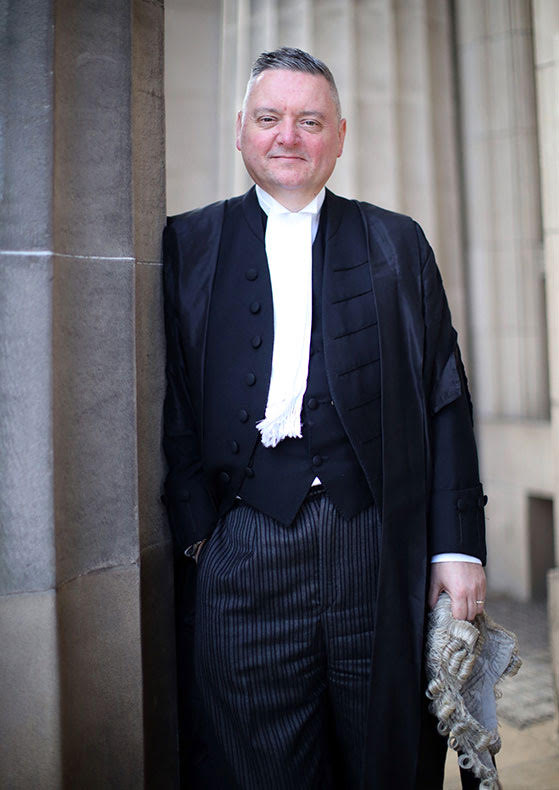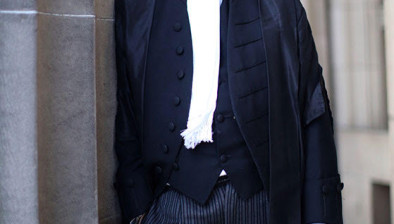Thomas Ross QC: Remember William Beck

Thomas Ross QC
Thomas Ross QC reflects on the late William Beck’s fight to clear his name.
STV news recently reported that William Beck, aged 59, suffered a fatal heart attack on 20th May 2020 while with his family in Glasgow.
The name of William (known as ‘Wullie’) Beck will be familiar to all regular readers of the Scottish Criminal Case Reports. I first met him in 2019. By then almost 30 years had passed since his conviction in the High Court at Livingston and he had long since served the sentence of six years’ imprisonment; yet his commitment to set that conviction aside had not wavered.
In describing his determination I cannot improve upon the assessment of the Scottish Criminal Cases Review Commission (in 2012) “more importantly, to suggest that the applicant has refused to acquiesce in his conviction would be a serious understatement. He has protested his innocence consistently since his conviction. As well as pursuing an appeal following his conviction (despite the absence of legal assistance) he complained about the conduct of the identification parade post-trial … He applied a number of times to the office of the Secretary of State for Scotland to have his case referred to the High Court. He made a further attempt to open up an avenue of appeal by applying direct to the court in 2006 … He attempted to petition the nobile officium …. He has engaged the assistance of MSP’s and of the Innocence Project. He has applied to the SCCRC on three occasions … the breadth and persistence of the applicant’s conduct in pursuing his claims of miscarriage of justice is striking and is unlike any other applicant the Commission has encountered”.
Was Wullie Beck the victim of a miscarriage of justice? The indictment alleged the robbery of two post office workers during a cash collection at the Safeway in Livingston on 12th December 1981. There seems to have been little doubt that the robbery was committed by two men who were pursued on foot to a get-away car (a Ford Grenada stolen earlier that day in Glasgow) in which they made their escape. As put by the trial judge (Lord Dunpark) in his charge to the jury, although other civilians saw part of the incident, the case against William Beck ultimately rested upon identifications of William Beck made by two eye witnesses, A and M.
Cases based solely upon identification by eye witnesses have given British lawyers cause for concern for more than a hundred years. Ironically, a notorious miscarriage of justice almost a century earlier had involved a different Beck, Adolf Beck, convicted in 1896 at the Old Bailey. In 80 years the problem had not gone away and in 1974 the Home Secretary appointed a committee, chaired by Lord Devlin, to consider ‘the wrongful convictions of Mr Luke Dougherty and Mr Lazlo Virag’ – in both cases ‘wrongful’ because honest witnesses acting in good faith had simply identified people who had had absolutely no involvement in the relevant crime.
Scotland had of course experienced its own problems – the Bryden Report (1978) listed cases where Royal Pardons had followed Scottish convictions based upon erroneous identifications. In a country of only five million citizens no fewer than four Royal Pardons had been granted in a period of seven years. The list included the case of Maurice Swanson who had been convicted in the High Court in Glasgow on 28th August 1974 then pardoned on 25th July 1975. Swanson had been identified by three witnesses, two bank tellers and an independent female who had been standing at a nearby bus stop - yet was completely innocent of the crime.
Scotland’s response to the Devlin Report came in the form of a Practice Note on Identification Evidence, issued in 1977 by the Lord Justice General (Emslie) which referred to, ‘the case in which the only evidence inculpating the accused … is evidence of visual identification by witnesses in circumstances in which their opportunity for accurate and reliable observation … has been limited in time … or merely fleeting and where the accused was not previously known to them … In such a case … the risk of conviction on mistaken identification by honest witnesses cannot be wholly excluded’. The case of William Beck was such a case – so how ‘risky’ were the identifications upon which the conviction was based?
There is very little noteworthy about the identification made by witness A. He was aged 36 at the relevant time and appears to have had an occupation that would require study and intelligence. He ran to the Ford Grenada upon hearing and seeing the uproar and claimed to have obtained a good look at the driver, who he identified as William Beck at a subsequent identification parade.
In Scotland, a case cannot succeed on the basis of the evidence of one witness, so where did the necessary corroboration come from? In that respect the investigating officers were fortunate – a police constable stationed at Livingston police office resided in a neighbouring street. Indeed they were doubly fortunate; on a cold December afternoon many Livingston residents would have been safely sheltered indoors – as the Ford Grenada sped off police constable M was out in the street cleaning his car and thus able to see the driver.
At the relevant time, the conduct of an identification parade in Scotland was regulated by ‘Interim Guidelines’ which were later replaced by ‘Guidelines’ which had been approved by the Secretary of State and the Lord Advocate (the two sets were found by the Scottish Criminal Cases Review Commission to be ‘in all material respects the same’). The central principal of the Guidelines was that ‘every precaution should be taken to see that identification parades are fairly conducted and, in particular, to exclude any suspicion of fairness …’. The need to conduct the identification parade in a way that excluded any ‘suspicion of unfairness’ was particularly acute in William Beck’s case because witness M was Police Constable M, stationed at the venue of the identification parade. In these circumstances it was perhaps reasonable to expect something close to rigid compliance with the Guidelines; so how did Strathclyde Police perform?
Clause 30 of the Guidelines provided that “if a witness makes a positive identification from photographs other witnesses should not be shown photographs but should be asked to attend an identification parade”. On Sunday 13th December 1981 a female eye witness (witness C) had been shown books of photographs at Livingston police office and had selected a photograph of William Beck as someone who ‘resembled the person whose face she had seen before she crossed the road to run down the path’. On Tuesday 15th December 1981, a second witness, PC M was shown photographs at Livingston police office, the office at which he was stationed, and selected an image of William Beck.
Clause 31 of the Guidelines provided that “prior to any identification parade, the defence are entitled to be advised of any earlier identification made from photographs by any witnesses viewing the parade”. Witness C and PC M both made ‘identifications’ from photographs then viewed the identification parade. There is nothing in the papers to suggest that this was disclosed to the defence at any stage.
Clause 10 of the Guidelines provided that “the accused should be placed beside persons of similar age, height and general appearance”. The police elected to place William Beck in a parade with five stand-ins; the minimum number permitted by the Guidelines. The Scottish Criminal Case Review Commission later agreed that “one of the stand-ins selected was not sufficiently similar in general appearance to be a suitable stand-in in terms of the Guidelines”.
Further, the Guidelines had clauses designed to prevent officers ‘connected with the enquiry’ assisting with the entry and exit of witnesses. One of the officers who assisted with the entry of witnesses that day was DC P – stationed at the same police office as PC M and involved in the arrest of William Beck earlier that day. The solicitor who protected William Beck’s interests at the Identification Parade had responded to the entry of PC M to the parade room by immediately noting upon his papers ‘ID too positive – ID without even looking down parade’.
In short, in a case that depended upon the absolute minimum of two sources of evidence linking William Beck with the crime, no fewer than four arguable irregularities can be identified in the conduct of the identification parade.
Add into the mix the fact that the getaway car was also seen by witness L, who had observed the face of the driver and described him as having “a moustache … about 40 years old”. Mr Beck had no moustache and was aged 20. Having viewed the parade L had been prepared to state “I would say that the driver was not on that parade”. L was not called as a witness.
William Beck believed that he had been badly treated by the Scottish criminal justice system and there were other unfortunate events which added fuel to his fire.
The trial judge had erred in directing the jury upon reasonable doubt telling them “for a verdict of guilty you need not be absolutely certain of guilt, and I emphasise, not absolutely certain, but you must be reasonable certain”. He had also made a slip of the tongue in dealing with the subject of majority verdicts “for a verdict of guilty you need a majority of eight … it really doesn’t matter so long as there is a majority of 8 in favour of an acquittal verdict”. William Beck was convicted by majority verdict.
The three judge bench that (in 2006) refused to extend the time limit within which to lodge an appeal included the son of the trial judge. The opinion of the court refusing leave to appeal was delivered by the counsel who had appeared for the Crown as advocate depute when the original appeal against conviction was refused in 1982. Given that his appeal had previously been argued (albeit without the benefit of legal representation) and refused, any combination of judges would have resulted in an identical outcome but mature legal systems operate on the basis that even a suspicion of bias should be avoided.
When he attempted to petition the Nobile Officium of the High Court in January his application for a warrant for service was refused by a single judge. When the review came before a court of five judges the Crown was not represented - there was no advocate depute in court.
I have no reason to doubt that both A and M genuinely and sincerely believed that William Beck was the driver of the get-away car but when dealing with identification evidence sincerity is part of the problem. As Lord Gardiner put it in a House of Lords Debate in 1974, “the danger of identification is that anyone in this country may be wrongly convicted on the evidence of a witness who is perfectly sincere, perfectly convinced that the accused is the man they saw, and whose sincerity communicates itself to the members of the jury who therefore accept the evidence”.
Equally, I have no reason to doubt William Beck’s assertion that he was innocent. It would not mean that witnesses A and M were dishonest, merely that they made an error of identification. The state would not have wasted resources on the Devlin and Bryden Committees if many errors of identification had not resulted in wrongful convictions in the past.
It is absolutely beyond doubt that William Beck lived the majority of his life like a person who had suffered a grave miscarriage of justice. I believe that no lawyer could have emerged from 30 minutes in his company with the same confidence in the trial and appeal process in Scotland.







